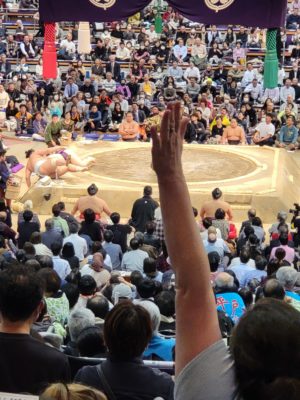
GRAND SUMO TOURNAMENT Day 11 Fukuoka 2023
I’m not much of a sports fan. I mainly watch the Super Bowl for the ads and halftime show. But when my husband and I were planning our first trip to Japan, to his surprise I suggested we take in sumo wrestling. I saw it as quintessential Japanese entertainment, like a tea ceremony with a geisha, albeit between two obese men in loincloths pushing each other. He was not enthusiastic. I argued it was similar to experiencing Jai Alai in Basque country, or watching people get married by Elvis in Las Vegas. I now cringe at my naïve and disrespectful view.
WHAT I’VE LEARNED ABOUT SUMO (SO FAR)
Sumo began 1500 years ago in Japan as part of annual harvest festivals and has had various refinements since. Not only does it require enormous discipline, devotion, skill, flexibility, and balance, it’s rooted in Shinto ritual taken so seriously that the traditionally dressed gyōji (referee) carries a dagger to show he is willing to commit seppuku (hara-kiri) if he makes a mistake. These days they will resign instead of kill themselves. Many have been badly injured when getting in the way of two humongous men fighting.
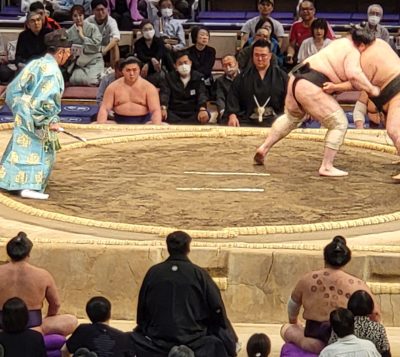
A sumo-in-training joins a heya (stable) between age 15 and 25 and lives under strict conditions until he reaches a certain rank and can live elsewhere and marry. Many will not reach that rung in the sumo ascension. Each rank only has so many slots to fill. Meanwhile, they serve rikishis (don’t call them wrestlers) ranked above them. They spend the morning training on an empty stomach and doing chores. Lunch is a large, protein-rich stew of chanko-nabe followed by rest. That puts on the pounds.
They are forbidden to drive at any rank. Women cannot set foot in the dohyo, the elevated 15-foot in diameter ring where sumo takes place. As of this writing, sumos are not allowed to post on social media personally.
Sumo matches can be seen during the six 15-day grand tournaments held throughout the year. Three are in Tokyo, the others are in Osaka, Nagoya, and Fukuoka. Tickets go fast.
MY SUMO EXPERIENCE
I grabbed tickets the day they went on sale for the Fukuoka hon-basho (grand tournament) in November. By now my husband was on board for the ramen Fukuoka is known for and pop-up nightly food stalls along the river. The company we bought tickets from, BuySumoTickets.com, created the app A Day at Sumo that was an invaluable resource leading up to the match and while we were there.
Sadly, the only active Yokozuna — the highest rank of sumo — was out of the competition due to an injury. Terunofuji Haruo stands 6’ 3”, weighs over 370 pounds, and has adorable bee stung lips and piercing solemn eyes. He’s only the 73rd Yokozuna since the honor began in the 1600s. The white zigzag lines on a Yokozuna’s belt mirror similar ones on Shinto shrines. This life-size cutout was the closest I got to him. His Insta feed provides a daily fix. Actually, it’s his fan club that posts.

73rd Yokozuna, Terunofuji, awaits your selfie.
At the Fukuoka Kokusai Center my excitement skyrocketed. I joined the throngs waiting for glimpses of sumos coming and going. The tournament lasts all day with the most important matches in the afternoon. We found our box seats with cushions and enough room to stretch our legs (no shoes allowed). I revved up A Day At Sumo. With all the announcements in Japanese, I had no idea what match we were seeing. It was still mesmerizing to watch the pre-match posturing that lasted longer than the actual match, spills off the two-foot high dohyo with sumos often landing on people sitting there, and some sumos locking like two embattled walruses as they clung to each other’s mawashi (30-foot neatly wrapped loincloth). In one such bout, the gyōji marked where the sumos’ feet were placed, they took a break and then locked up again in the same location. The crowd went nuts when it was over, as did I.
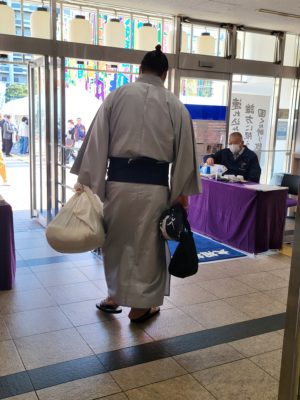
Quittin’ time for one sumo
Then came the Makuuchi round, the top division. The East side (higher ranked) contenders marched in as their names were called, mounted the stage, formed a circle, did synchronized movements with their arms and a quick lift of their colorful ceremonial apron (keshō-mawashi). They left and the West side entered from another area and repeated the performance. I could now follow the list of who was fighting that day on a sheet printed daily based on what happened the day before.
The arena accommodated 10,000 fans and was now full. Each match brought us closer to the top ranked rikishis. The crowd’s passion swelled with yelling and banner-waving. The pre-match rituals went on longer. Tossing salt into the ring, slapping one’s belly, lifting an outstretched leg and balancing for a moment is all done to ward off bad spirits. A match begins when it is mutually agreed upon between the sumos. That means one rikishi can go through all the motions, squat down like he’s ready, then say phooey and stand up. Or everything stops as sponsors emblazoned on banners are walked around the ring by people you can’t see because the banners are so large. The closer to the final match, the more sponsors appear.
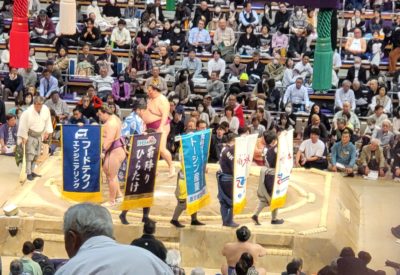
There are 82 ways to maneuver in sumo but basically two styles: grabbing the other’s mawashi and lifting the opponent out of the ring, or slapping. No punching. No grabbing the ginko-shaped topknot. Only the feet are allowed to touch the floor of the ring. If a sumo falls or touches the ground with their hand or any other part of their body, they’ve lost.
Still, it’s not over. They both return to the ring, the loser bows their head to the victor (how deep the bow is significant), the victor squats, the gyōji stands before him with envelopes filled with winnings (half goes to the sumo then, half to his retirement fund), the rikishi waves his hand over it in a certain way, takes it and leaves.
When the matches are over for the day, this performance is done. A lot of people left during it, but many, like myself, stayed and watched in awe.
Now that I’ve watched many tournaments on NHK.com, I’m deeply impressed by how humble the rikishis are in post-bout interviews, underscoring the honor and spirituality every sumo brings to this calling. Is there any other sport like that? I’m not even sure the term “sport” should be used.
Watching live sumo was the highlight of an endlessly fun and exotic trip to four Japanese cities and the Art Islands. I had to control myself with the sumo souvenirs due to limited baggage space.

Stuffed sumo repurposed as a Christmas ornament.
The printed materials given to us when we entered the event contained a long poster of nine rikishis with Terunofuji in the middle. They now encourage me to up my game when I’m on my rowing machine.
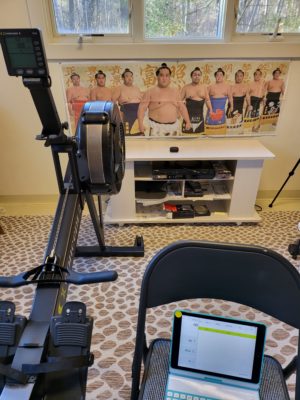
Shodai, Hoshorya, Takakeisho, Terunofuji, Kirishima, Meisei, Kotoeko, Sadanoumi, Hirodoumi.
The simplest armchair introduction to sumo:
- Go to Japan’s version of the BBC, NHK.com LIVE and look in the lower right corner below the screen showing what’s live. Pick your language and click on WEEKLY SCHEDULE to see when their coverage of the Grand Sumo Tournaments is coming up (six times a year for 15 days). Or go to the search bar and type in Sumo to find all kinds of shows on demand. When it’s live, be sure to watch the short Sumopedia segment at the very end.
- For lighter moments of sumo that will bring laughter to your life every day (for example, what do these huge men carry in their tiny man bags?), join the SumoSumoSumo group on Facebook and watch the Sumo Out of Context series on YouTube. If a video is in Japanese, hold Google Translates camera up to the screen. From there, watch out! You’ll be sucked up into another world.
 Renee Poli says
Renee Poli says
December 30, 2023 at 9:20 pmHow interesting! Thanks for writing about your adventure!